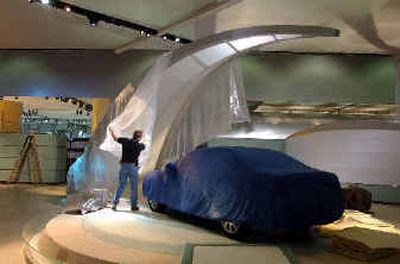Auto show is more than cars

DETROIT — It’s more like Walt Disney World than just “cars on carpet” these days at the annual North American International Auto Show.
Visitors to the 2005 extravaganza in Detroit, which opens to the public Jan. 15, have come to expect intricate lighting displays, huge video walls and even waterfalls. And as new technology emerges, the entertainment component is only intensifying.
“Over the last 25 to 35 years, it’s gone from cars on carpet to very integrated, total brand experiences,” said Michael Thoresen, vice president of Detroit-based Exhibit Works, which designs many of the automakers’ displays. “We take a lot of cues from … theme parks.”
Detroit is a showcase for some of the most cutting-edge exhibits. Despite increasing competition from auto shows in Chicago, New York and Los Angeles, the industry’s hometown still is considered the most important U.S. venue, exhibit designers say. Internationally, four other shows — Frankfurt, Paris, Tokyo and Geneva — compete with Detroit in the major leagues.
The economic impact of this year’s show is estimated at $580 million, according to a study by David Sowerby, portfolio manager at Loomis Sayles & Co. Much of that is the direct cost of producing the exhibits. Companies spend about $4 million to $8 million to completely revamp each brand’s exhibit every three years, said Scott Stubbs, chief executive of Warren-based exhibit producer H.B. Stubbs Co.
Thoresen says it’s money well-spent, because the events attract consumers.
Among marketing efforts, “auto shows are still at the top of the list in terms of delivering the highest return on investment … because 60 percent of people who go to auto shows are going to be in market within the next 12 months,” he said. “This gives automakers a chance to really solidify the deal or be added to the consideration list.”
Last year, the Detroit show hosted 6,600 journalists and nearly 809,000 members of the public. The show is a major destination for families, and with tickets costing $12, people often spend an entire day. Popcorn, pizza and hot dogs are sold in the lobby outside the exhibit hall.
Just days before a media preview scheduled for Sunday, Cobo Center was buzzing with the sound of power tools as workers installed carpeting and lighting around draped vehicles and tested sound systems, giant video monitors and fountains.
Designers say automakers want displays that will attract foot traffic, while promoting the virtues of their product.
An exhibit by DaimlerChrysler AG’s Jeep brand, for example, features a cityscape on one side and a mountain with a waterfall on the other — illustrating what the automaker believes is its vehicle’s versatility in urban and rural environments.
“When you walk into that display, that helps you understand what Jeep means,” Chrysler Group spokeswoman Suraya DaSante said.
This year, the Jeep area will also include an interactive gaming zone designed to impress the high-tech crowd.
Indeed, electronic wizardry and special effects are a growing part of most exhibits. Bob Albitz, senior vice president of the George P. Johnson Co., an Auburn Hills-based exhibit firm, says the expansion of LED technology, which stands for light-emitting diodes, in particular has driven the show’s evolution. The technology — which is commonly used in outdoor, jumbo TV screens — offers “amazing brightness and resolution,” Albitz said.